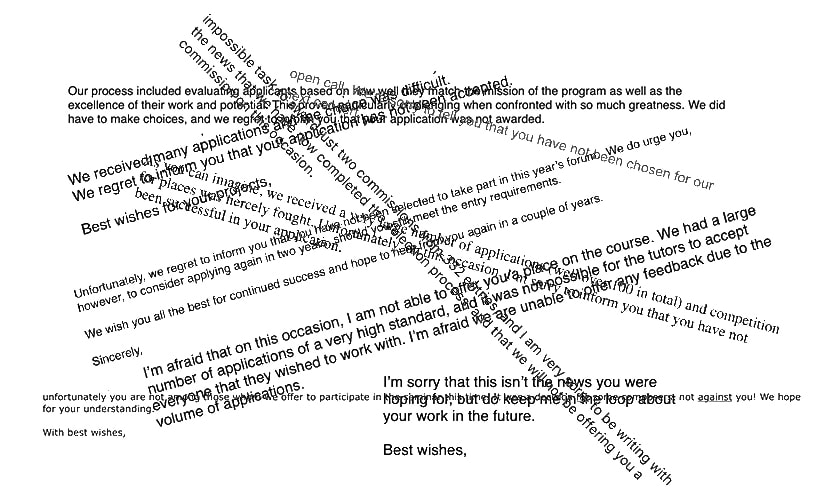|
It has been a disastrous half-year for applications. I have applied to fifteen composition opportunities so far this year and received thirteen rejections (my final two rejections are pending by the 20th July). Numbers soothe my soul, so I have been carefully quantifying my rejection. I thought it might be encouraging. I know that I have low odds of scoring any given opportunity but maybe, in aggregate, my odds aren’t that bad. Take, for example, the LSO’s Panufnik scheme. Around 150 people apply and six are selected, giving me a prior expectation that my odds are around 4% or 1 in 25. That’s pretty lousy. However, if these are about average for such opportunities, and I apply to 20 in a given year, my odds of getting at least one application are 4 in 7 (56%) each year, which isn’t too bad.
I started the year even more optimistic. Perhaps I am 25% more likely to get in than the average applicant, i.e. I have a 5% chance for each scheme! That brings my odds of getting onto something to about 2 in 3 (64%). Perhaps I’m able to apply to 25 schemes! That brings my odds of getting something, anything becomes almost 3 in 4 (72%). However, the slew of rejections has taught me a little pessimism. If each scheme receives many more applicants per space that the Panfunik scheme my odds decrease precipitously. I have found out that the JACK Quartet received 443 for six commissions (1.3% success rate), MATA got 1119 for 24 places (2%), Listenpony received 140 for two commissions (1.4%) and Riot Ensemble received 332 for two opportunities (0.6%). Let’s average these out with Panufnik to create an average of ~2%. If I apply to 20 schemes, my odds of getting something are only 1 in 3 (33%). Each time I applied to something I predicted my chance of winning. My odds varied from a 1 in 8 chance of winning the Nonclassical Battle of the Bands final (i.e. slightly worse than average, given I was down to the last six!) to a 1 in 50 chance of winning the JACK Quartet commission (slightly above the true average, as it turns out). This is an idea called “prediction calibration”, and can be a very useful tool for decision making. So what has all this number-crunching taught me? My odds are worse than I thought I went in without much information about my chances: I knew that I had won a couple of competitions, so reckoned my odds to be between 5% and 10%. Looking more carefully at stated applicant numbers has made realise I should expect my chance to be more like 2%. Don’t spend too much time on applications. Agonising over the cover letter for something you’ve only got a 3% chance of winning is an obvious waste of time. Now I write them in one sitting, whack it through Grammarly and send it off. Applying to one extra scheme per year increases your chance of success much more than making that application 10% better. You’re also more likely to become emotionally attached to something you put more time into, which is unlikely to be worth it! Keep applying! The aggregate number of applications you send off makes a big difference. I’ve applied to 15 things so far this year: if I can hit 30 by December, I can get my total odds, even at 2% each time, up to almost 50/50. Opportunities should let you know the number of applicants to places (particularly if they want to charge you anything) There’s a massive difference in the likelihood that you’ll get onto Panufnik (5%) than that you’ll get the JACK’s Fulcrum commission (2%). Now, both of these are easy applications and well-run, so you might as well apply. But if there are significant hurdles to entering (writing a new piece, crafting a covering letter) or you have to pay, then you should know if the investment of time or money is worth your while. Listenpony, for example, charges £3 to enter and award a £500 fee. Even at 1.4%, this £3 is worth it. Were it £10, though, you’d be wise to think twice. I realise this might be an unconventional way of looking at things, and that some people might be put off from applying were they to see the true odds. I wonder if this is a bad thing: it might not always be wise to apply if the odds are terrible! But then this might have a greater effect on those with lower confidence, exacerbating existing inequalities of race, class and gender. However, maybe displaying their terrible odds would pressure competitions to be more worthwhile. I’d be really interested to know what people think about this issue! Don’t let failure get you down Your chance of winning competitions is more dependent on how many applications you make and how many other people apply than how good you are. With such low chances of winning each opportunity, even being 25% more likely to win than the average entrant doesn’t yield much joy. I know we all already know this in theory, but, crunch the numbers and see: competitions are primarily luck, don’t let the bastards get you down.
0 Comments
Leave a Reply. |
NewsYou can find out about recent and upcoming projects here, and stay up-to-date with email or RSS below.
Archives
July 2024
|
|
All photographs by Ilme Vysniauskaite
|

 RSS Feed
RSS Feed